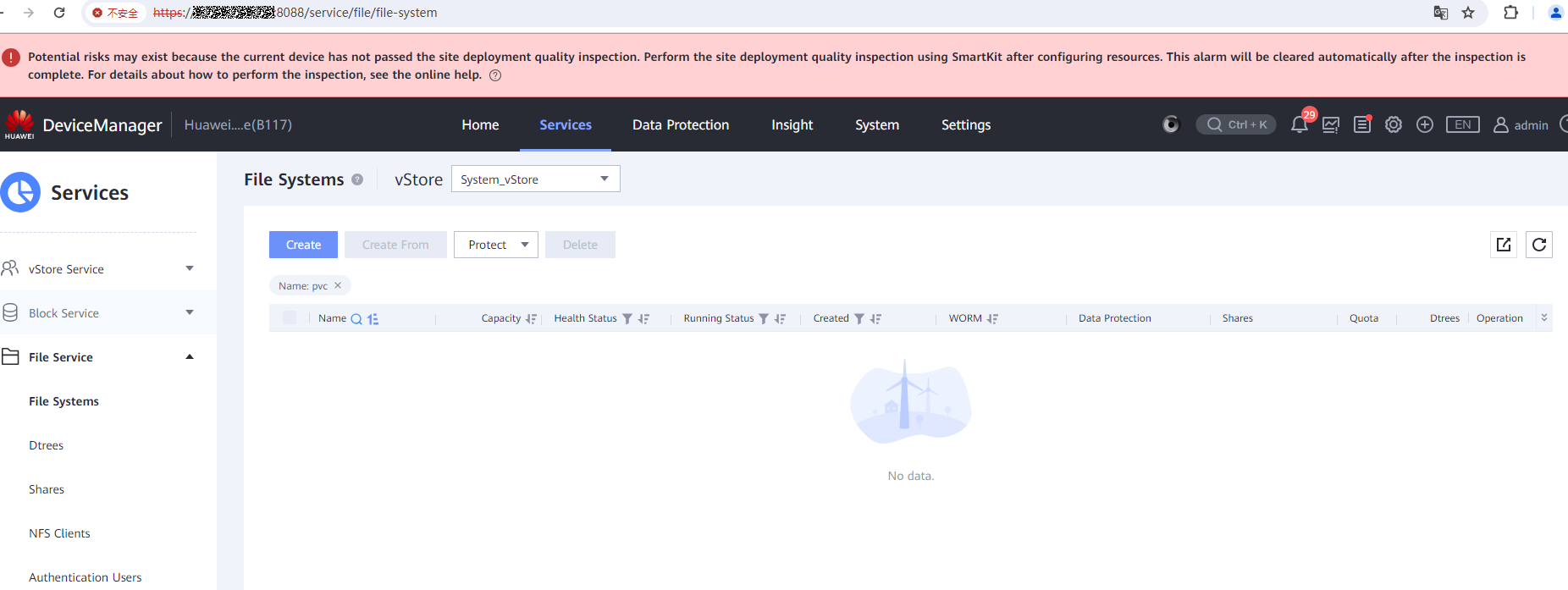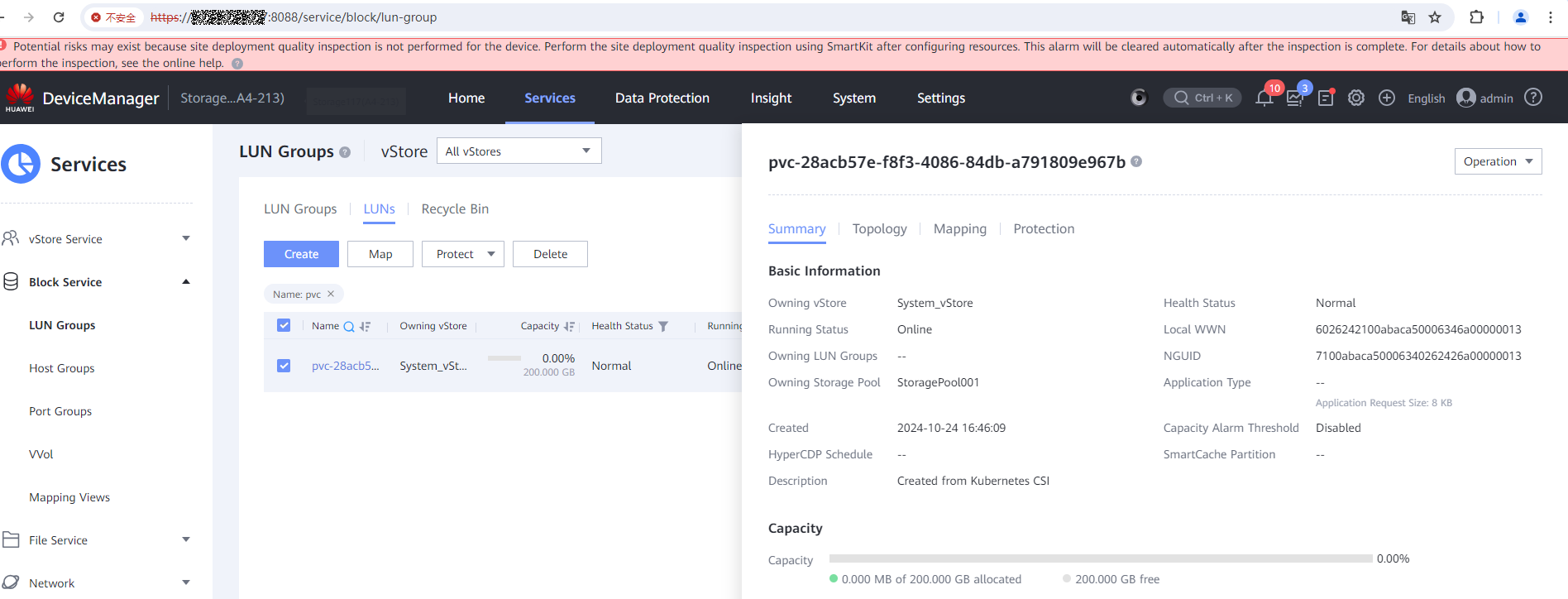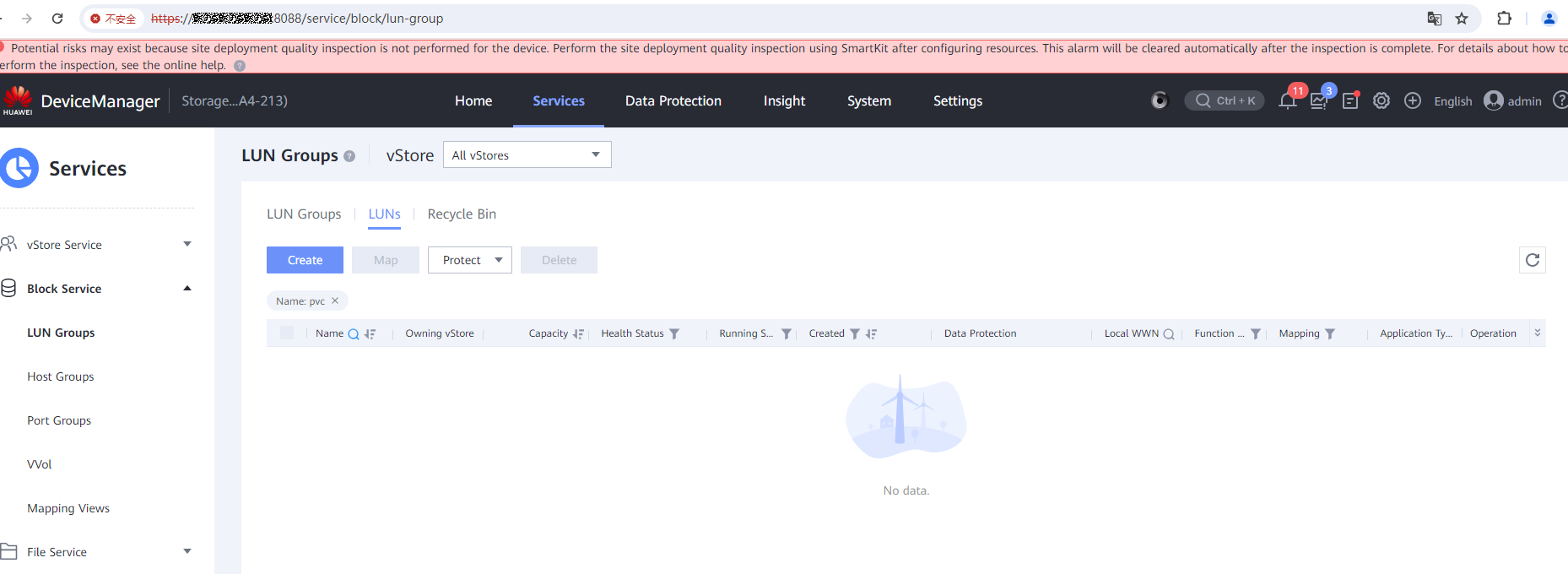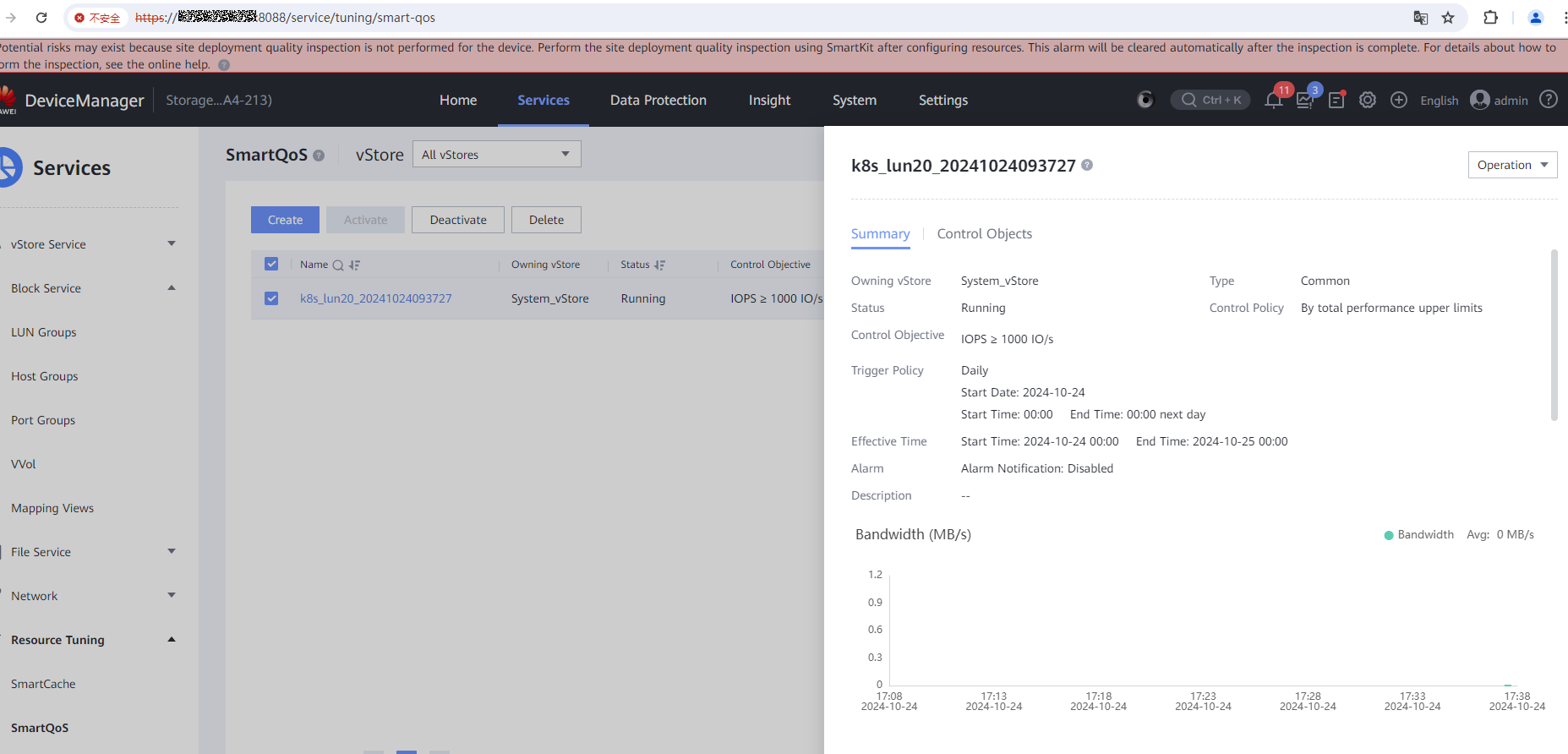Huawei OceanStor Dorado All-Flash Storage and Red Hat OpenShift
Interoperability Test Report![]()
Axians Global
All Rights Reserved
Executive Summary
Axians Global (“Axians”) assessed the interoperability of Red Hat OpenShift and Huawei OceanStor Dorado All-Flash Storage (hereinafter referred to as “the storage” as well). The goal of the assessment is to validate that Red Hat OpenShift is interoperable with Huawei OceanStor Dorado All-Flash Storage.
All the test cases were completed and passed. With regards to the test results, Red Hat OpenShift can recognize and use Huawei OceanStor Dorado All-Flash Storage correctly.In summary, the result of this test proves Huawei OceanStor Dorado All-Flash Storage can be compatible with Red Hat OpenShift.
Test Scenario | Storage Involved | Result |
OpenShift Basic Function – SAN | OceanStor Dorado All-Flash Storage | Passed |
OpenShift Basic Function – NAS | OceanStor Dorado All-Flash Storage | Passed |
In this document, you will find details on the above test cases and the captured output. The procedures conducted in the tests are referenced from standard online documentation from Red Hat and Huawei.
1.Environment Configuration
1.1 Networking diagram
Figure 1 Huawei OceanStor Dorado Storage Function Compatibility Test Networking 1

Networking description:
- Deploy one ESXi physical host, install the VMware VM software, create a VM for deploy the OpenShift nodes.
- Deploy the Red Hat OpenShift: Use the Linux VM servers as the OpenShift nodes.
- The management network and service network are connected to the OpenShift nodes and Huawei storage through switches.
- Management network and service network of all storage devices connect to the OpenShift nodes through 10g Ethernet.
1.2 Hardware and Software Configuration
1.2.1 Storage Configuration
Table 1-1 Huawei storage configuration table
Name | Model | Version | Quantity |
Storage | Huawei OceanStor Dorado All-Flash Storage (Hereinafter referred to as “Dorado” as well) | V6 | 1 |
1.2.2 Matching Hardware Configuration
Table 1-2 Hardware Configuration
Name | description | Usage | Quantity |
VMWare ESXi | x86 server
| Deploy the VM for OpenShift wallaby nodes. | 1 |
Ethernet switch | Huawei 6855 10GE Network Switch | Ethernet switches for service and management networking. | 1 |
1.2.3 Test Software and Tools
Table 1-3 Test Software and Tool List
Software Name | description | Version | Quantity |
VMWare ESXi | VMware virtualization platform | 7.0.U2 | 1 |
Red Hat OpenShift | An open source cloud platform management project | 4.16 | 1 |
Huawei CSI | A plug-in deployed on the OpenShift. | 4.5.0 | 1 |
2.Test Cases and Records
2.1 The Storage And OpenShift 4.16 with NAS
2.1.1 Install Huawei CSI through Helm
Test Purpose | To verify that the Huawei CSI plug-in can be installed through Helm. |
Test Networking | Huawei OceanStor Dorado Storage Function Compatibility Test Networking 1 |
Prerequisites | 1. The storage system is running normally. 2. Red Hat OpenShift is running normally. 3. The network between the storage and OpenShift is connected correctly. |
Test Procedure | 1. Import the image to the image repository. 2. Prepare the config file. 3. Start the Huawei CSI plug-in service and configure the storage. 4. Check the Huawei CSI plug-in service status. |
Expected Result | 1. In step 3, the Huawei CSI plug-in service started successfully and the storage is configured successfully. 2. In step 4, the status of Huawei CSI plug-in service is running. |
Test Results | 1. In step 3, the Huawei CSI plug-in service started successfully and the storage is configured successfully. 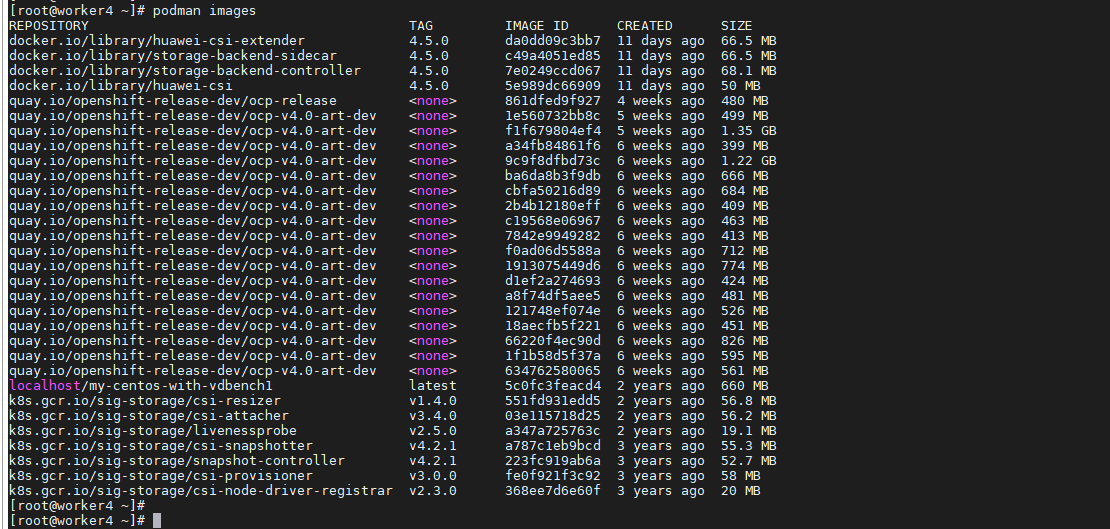
2. In step 4, the status of Huawei CSI plug-in service is running.  |
Test Conclusion | Passed |
2.1.2 Create, query and delete SC
Test Purpose | To verify that the SC can be created, queried and deleted successfully. |
Test Networking | Huawei OceanStor Dorado Storage Function Compatibility Test Networking 1 |
Prerequisites | 1. The storage system is running normally. 2. Red Hat OpenShift is running normally. 3. The network between the storage and OpenShift is connected correctly. 4. Huawei CSI plug-in is configured and started normally. |
Test Procedure | 1. Create and configure StorageClass config file. 2. Use oc create -f oceanstor-sc.yaml command to create SC. 3. Use oc get sc command to query SC. 4. Use oc delete sc command to delete SC. |
Expected Result | 1. In step 2, SC is created successfully. 2. In step 3, SC is queried successfully. 3. In step 4, SC is deleted successfully. |
Test Results | 1. In step 2, SC is created successfully. 
2. In step 3, SC is queried successfully.  3. In step 4, SC is deleted successfully.  |
Test Conclusion | Passed |
2.1.3 Create, query and delete PVC
Test Purpose | To verify that the PVC can be created, queried and deleted successfully. |
Test Networking | Huawei OceanStor Dorado Storage Function Compatibility Test Networking 1 |
Prerequisites | 1. The storage system is running normally. 2. Red Hat OpenShift is running normally. 3. The network between the storage and OpenShift is connected correctly. 4. Huawei CSI plug-in is configured and started normally. |
Test Procedure | 1. Create and configure PersistentVolumeClaim config file, the capacity of lun is 200GB. 2. Use oc create -f oceanstor-pvc.yaml command to create PVC. 3. Use oc get pvc command to query PVC. 4. Use oc get pv command to query PV. 5. Use oc delete pvc oceanstor-pvc command to delete PV. |
Expected Result | 1. In step 2, PVC is created successfully. 2. In step 3, PVC is queried successfully. 3. In step 4, PV is queried successfully, the corresponding filesystem and share of the PVC is created successfully on the storage. 4. In step 5, PVC is deleted successfully, the corresponding filesystem and share of the PVC is deleted successfully on the storage. |
Test Results | 1. In step 2, PVC is created successfully.  2. In step 3, PVC is queried successfully.  3. In step 4, PV is queried successfully, the corresponding filesystem and share of the PVC is created successfully on the storage. 
4. In step 5, PVC is deleted successfully, the corresponding filesystem and share of the PVC is deleted successfully on the storage. 
|
Test Conclusion | Passed |
2.1.4 Create, query and delete Pod
Test Purpose | To verify that the Pod can be created, queried and deleted successfully. |
Test Networking | Huawei OceanStor Dorado Storage Function Compatibility Test Networking 1 |
Prerequisites | 1. The storage system is running normally. 2. Red Hat OpenShift is running normally. 3. The network between the storage and OpenShift is connected correctly. 4. Huawei CSI plug-in is configured and started normally. |
Test Procedure | 1. Create and configure the Pod config file. 2. Use oc create -f oceanstor-pod.yaml command to create Pod. 3. Use oc get pod command to query Pod. 4. Use oc delete pod command to delete Pod. |
Expected Result | 1. In step 2, Pod is created successfully. 2. In step 3, Pod is queried successfully. 3. In step 4, Pod is deleted successfully. |
Test Results | 1. In step 2, Pod is created successfully. PVC is created successfully.  Pod is created successfully.  2. In step 3, Pod is queried successfully.  3. In step 4, Pod is deleted successfully.  |
Test Conclusion | Passed |
2.1.5 Configure storage Qos policy with CSI plug-in
Test Purpose | To verify the Qos policy can be configured on the storage with CSI plug-in |
Test Networking | Huawei OceanStor Dorado Storage Function Compatibility Test Networking 1 |
Prerequisites | 1. The storage system is running normally. 2. Red Hat OpenShift is running normally. 3. The network between the storage and OpenShift is connected correctly. 4. Huawei CSI plug-in is configured and started normally. |
Test Procedure | 1. Create and configure the StorageClass config file, and configure the Qos parameter. 2. Create SC. 3. Create PVC. 4. Create Pod. |
Expected Result | 1. In step 2, SC is created successfully. 2. In step 3, PVC is created successfully, the corresponding filesystem and share is created on the storage with Qos policy configured in step 1. 3. In step 4, Pod is created successfully. |
Test Results | 1. In step 2, SC is created successfully.  |
Test Conclusion | Passed |
2.1.6 Configure PVC snapshot with CSI plug-in
Test Purpose | To verify the PVC snapshot can be configured successfully with CSI plug-in. |
Test Networking | Huawei OceanStor Dorado Storage Function Compatibility Test Networking 1 |
Prerequisites | 1. The storage system is running normally. 2. Red Hat OpenShift is running normally. 3. The network between the storage and OpenShift is connected correctly. 4. Huawei CSI plug-in is configured and started normally. |
Test Procedure | 1. Create snapshot for the original PVC. 2. Check whether the snapshot is created successfully on the server. 3. Check whether the snapshot is created successfully on the storage. |
Expected Result | 1. In step 2, the snapshot is created successfully on the server. 2. In step 3, the snapshot is created and actived successfully on the storage. |
Test Results | 1. In step 2, the snapshot is created successfully on the server. The SC is created successfully.  The PVC is created successfully.  The Pod is created successfully. 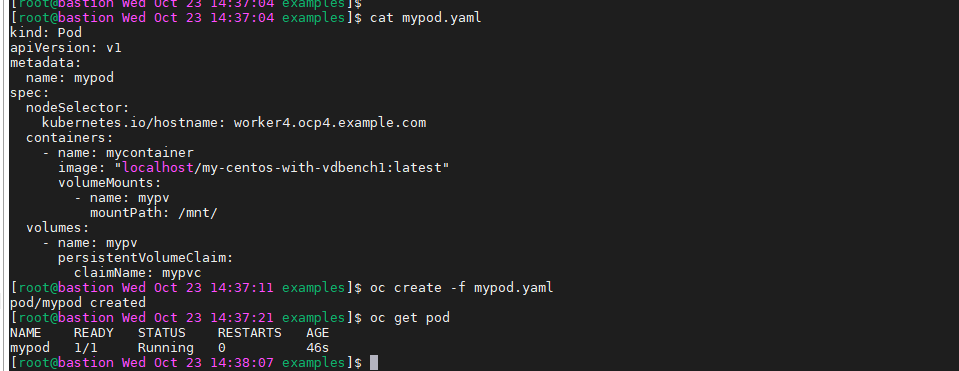 The test file is created successfully.  The snapclass is created successfully.  The snapshot is created successfully.  2. In step 3, the snapshot is created and actived successfully on the storage  |
Test Conclusion | Passed |
2.1.7 Delete snapshot
Test Purpose | To verify the snapshot can be deleted successfully with CSI plug-in. |
Test Networking | Huawei OceanStor Dorado Storage Function Compatibility Test Networking 1 |
Prerequisites | 1. The storage system is running normally. 2. Red Hat OpenShift is running normally. 3. The network between the storage and OpenShift is connected correctly. 4. Huawei CSI plug-in is configured and started normally. 5. The snapshot of PVC is created successfully. |
Test Procedure | 1. Delete the snapshot. 2. Check whether the snapshot is deleted successfully on the server. 3. Check whether the snapshot is deleted successfully on the storage. |
Expected Result | 1. In step 2, the snapshot is deleted successfully on the server. 2. In step 3, the snapshot is deleted successfully on the storage. |
Test Results | 1. In step 2, the snapshot is deleted successfully on the server.  2. In step 3, the snapshot is deleted successfully on the storage. 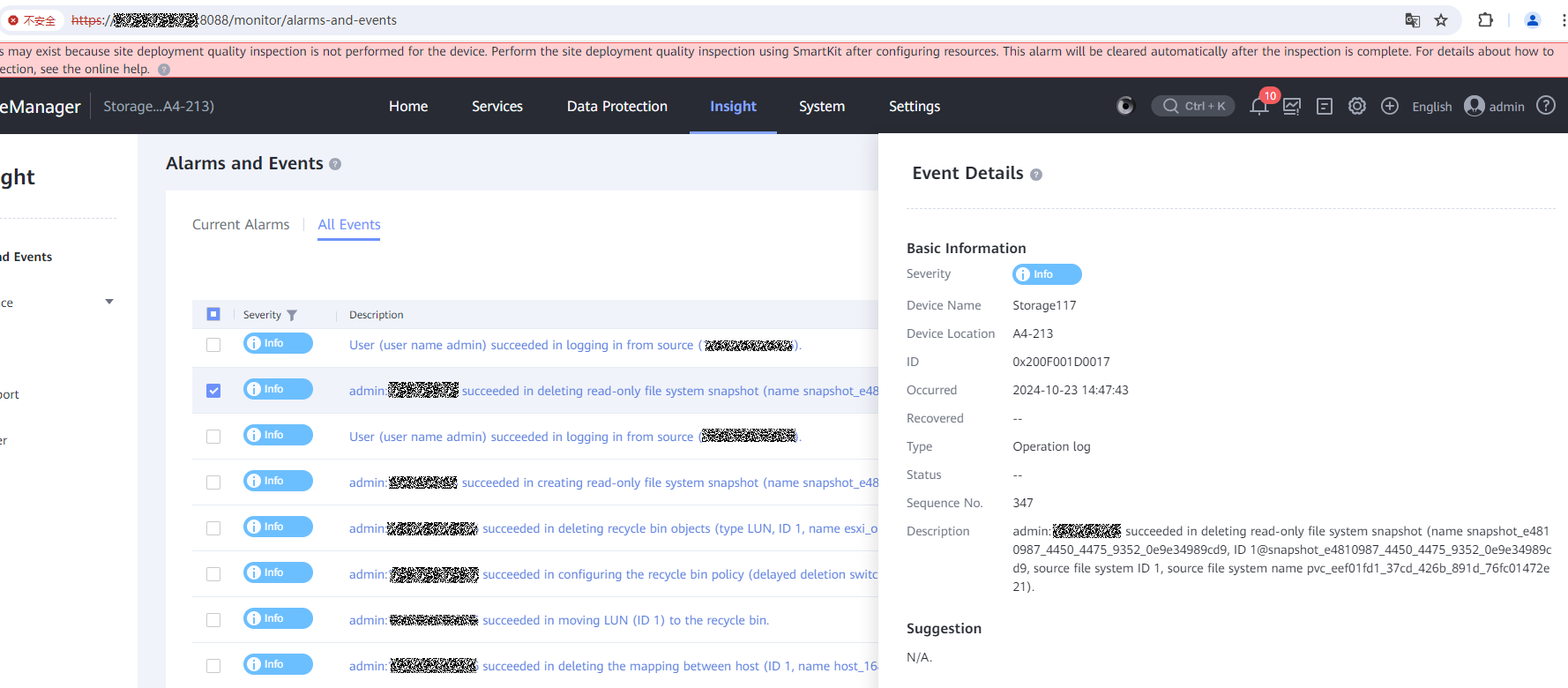
|
Test Conclusion | Passed |
2.1.8 Configure PVC capacity expansion with CSI plug-in
Test Purpose | To verify the PVC can be expanded successfully with CSI plug-in. |
Test Networking | Huawei OceanStor Dorado Storage Function Compatibility Test Networking 1 |
Prerequisites | 1. The storage system is running normally. 2. Red Hat OpenShift is running normally. 3. The network between the storage and OpenShift is connected correctly. 4. Huawei CSI plug-in is configured and started normally. |
Test Procedure | 1. Configure the PVC name and capacity parameter. 2. Expand the PVC. 3. Check the capacity of the PVC 4. Check the filesystem capacity on the storage. |
Expected Result | 1. In step 3, the PVC is expanded successfully on the server. 2. In step 4, the corresponding filesystem of the PVC is expanded successfully on the storage. |
Test Results | 1. In step 3, the PVC is expanded successfully on the server.  Check the capacity of the PVC after expansion  2. In step 4, the corresponding filesystem of the PVC is expanded successfully on the storage.  |
Test Conclusion | Passed |
2.1.9 Configure PVC clone with CSI plug-in
Test Purpose | To verify the PVC can be cloned successfully with CSI plug-in. |
Test Networking | Huawei OceanStor Dorado Storage Function Compatibility Test Networking 1 |
Prerequisites | 1. The storage system is running normally. 2. Red Hat OpenShift is running normally. 3. The network between the storage and OpenShift is connected correctly. 4. Huawei CSI plug-in is configured and started normally. |
Test Procedure | 1. Configure the yaml file of SC. 2. Configure the yaml file of PVC. 3. Create SC. 4. Create PVC through clone. |
Expected Result | 1. In step 3, SC is created successfully. 2. In step 4, PVC is cloned successfully, the corresponding filesystem of the cloned PVC is created successfully on the storage. |
Test Results | 1. In step 3, SC is created successfully. 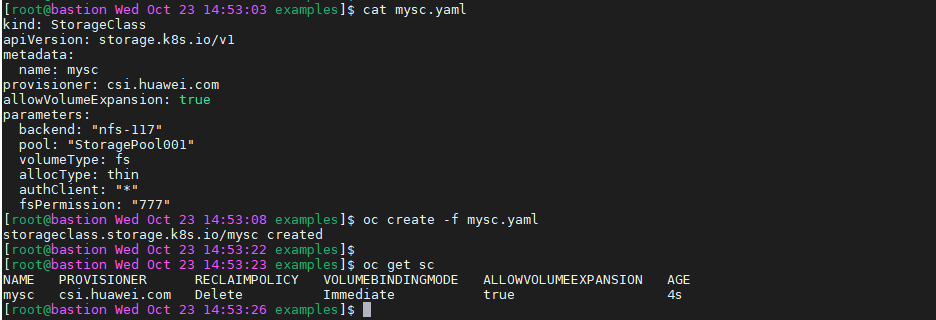 2. In step 4, PVC is cloned successfully, the corresponding filesystem of the cloned PVC is created successfully on the storage. The original PVC is created successfully.  The Pod of the original PVC is created successfully. 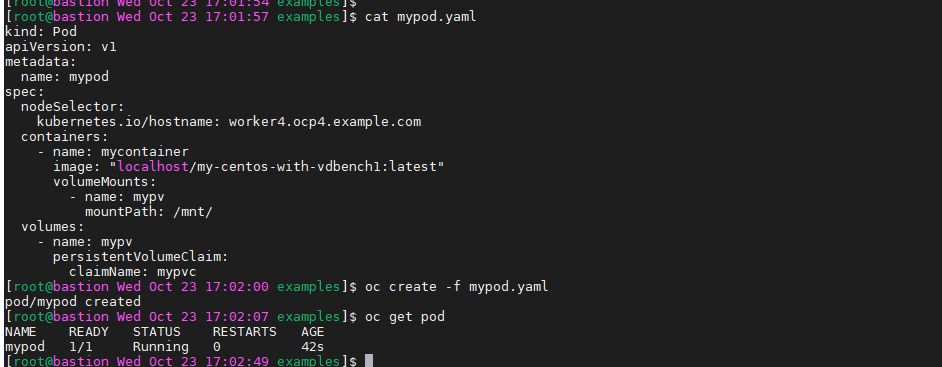 The test file is created successfully in the Pod.  The Cloned PVC is created successfully  Verify the corresponding filesystem of the cloned PVC is created successfully on the storage 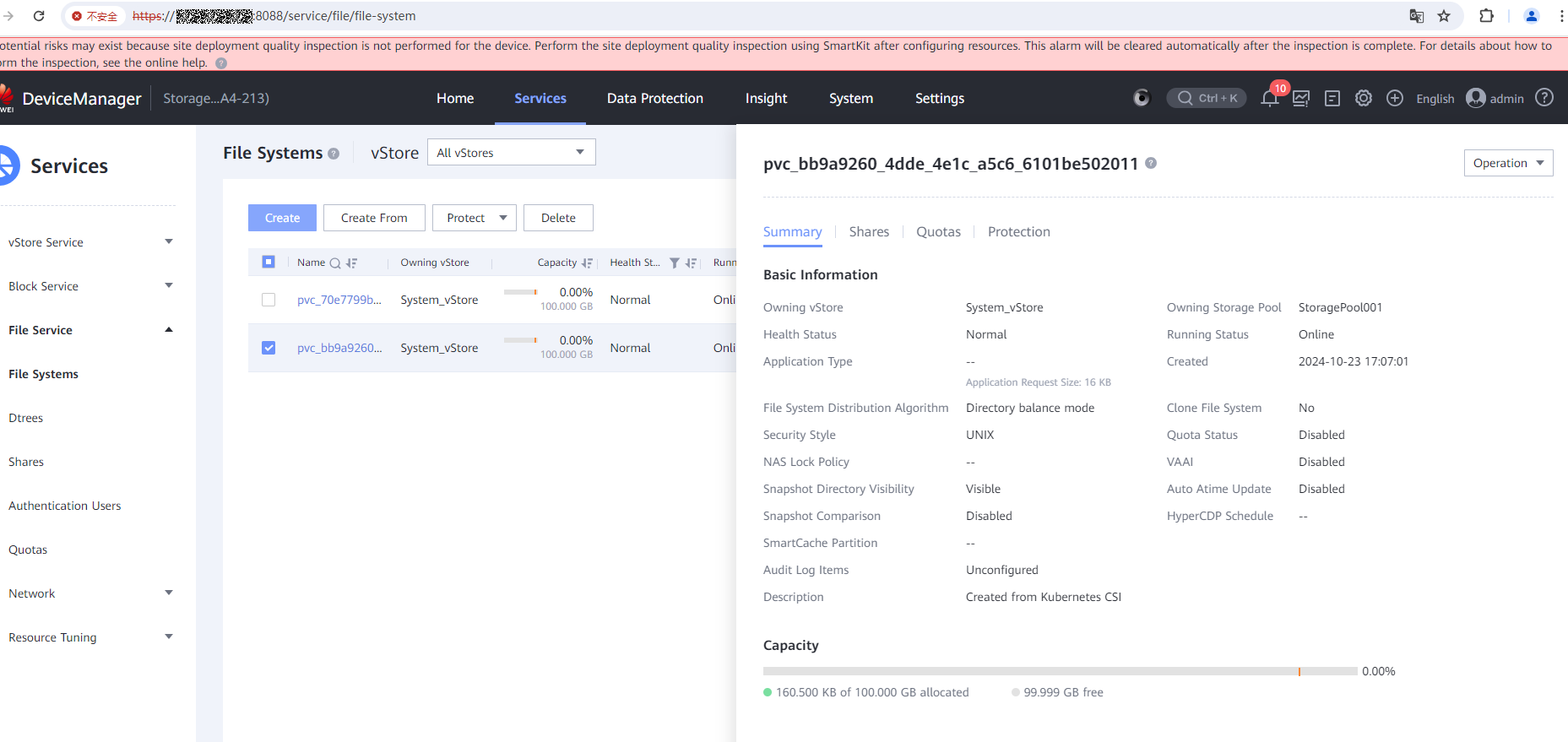 The Pod of the cloned PVC is created successfully  The contents in the test file are compared consistently.  |
Test Conclusion | Passed |
2.1.10 Create new filesystem from snapshot
Test Purpose | To verify that OpenStack allows deleting a VM. |
Test Networking | Huawei OceanStor Dorado Storage Function Compatibility Test Networking 1 |
Prerequisites | 1. The storage system is running normally. 2. Red Hat OpenShift is running normally. 3. The network between the storage and OpenShift is connected correctly. 4. Huawei CSI plug-in is configured and started normally. |
Test Procedure | 1. Configure creating filesystem from snapshot, The target capacity is greater than or equal to the capacity of the snapshot. |
Expected Result | 1. In step2, new PVC is created successfully. 2. In step 3, the new filesystem is created successfully on the storage. 3. In step 4, the data is consistent with the original PVC. |
Test Results | 1. In step2, the new PVC is created successfully.. The SC is created successfully.  The original PVC is created successfully.  The test file is created successfully in the Pod.  The snapshot is created successfully.  The snapshot is created successfully based on the PVC.  2. In step 3, the new filesystem is created successfully on the storage. 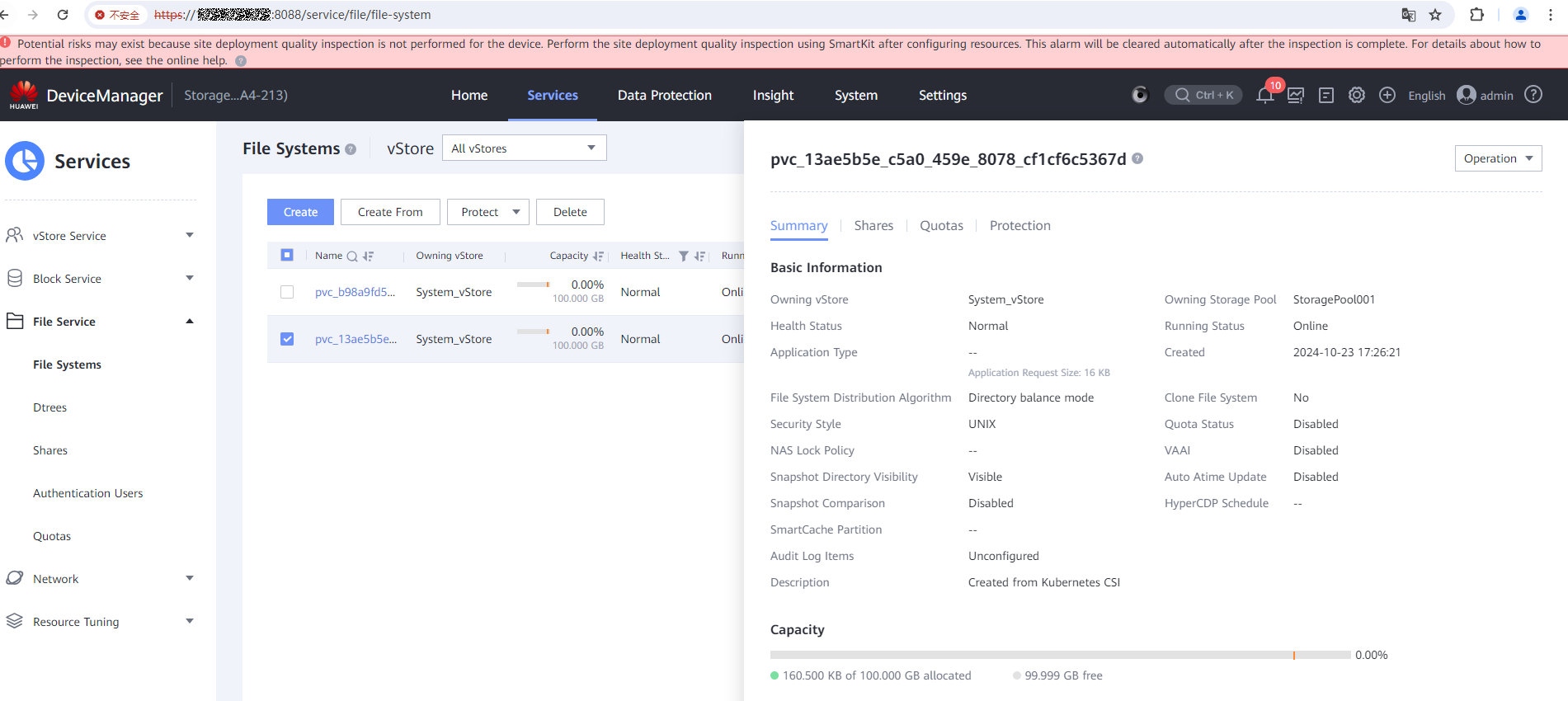 3. In step 4, the data is consistent with the original PVC. The Pod of new PVC is created successfully.  The contents in the test file are compared consistently.  |
Test Conclusion | Passed |
2.2 The Storage And OpenShift 4.16 with SAN
2.2.1 Install Huawei CSI through Helm
Test Purpose | To verify that the Huawei CSI plug-in can be installed through Helm. |
Test Networking | Huawei OceanStor Dorado Storage Function Compatibility Test Networking 1 |
Prerequisites | 1. The storage system is running normally. 2. Red Hat OpenShift is running normally. 3. The network between the storage and OpenShift is connected correctly. |
Test Procedure | 1. Import the image to the image repository. |
Expected Result | 1. In step 3, the Huawei CSI plug-in service started successfully and the storage is configured successfully. |
Test Results | 1. In step 3, the Huawei CSI plug-in service started successfully and the storage is configured successfully. 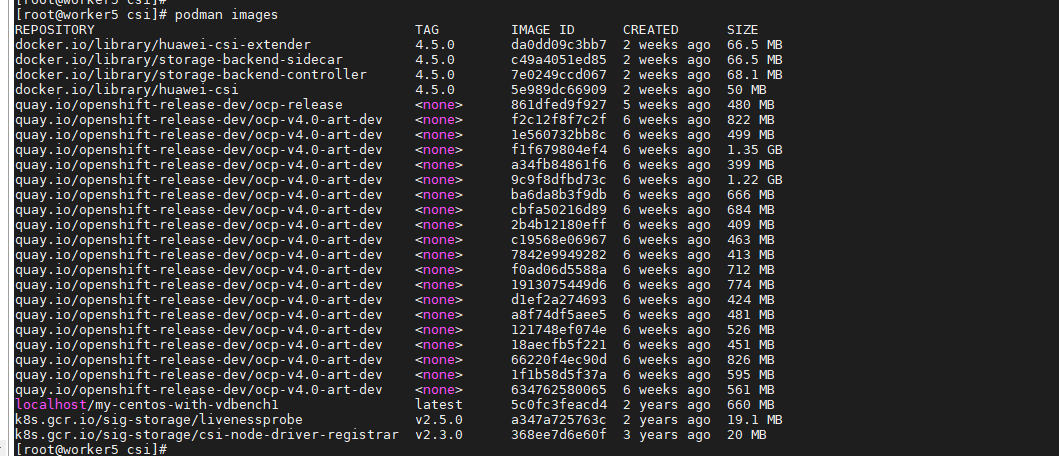
2. In step 4, the status of Huawei CSI plug-in service is running.  |
Test Conclusion | Passed |
2.2.2 Create, query and delete SC
Test Purpose | To verify that OpenStack allows creating a snapshot volume. |
Test Networking | Huawei OceanStor Dorado Storage Function Compatibility Test Networking 1 |
Prerequisites | 1. The storage system is running normally. |
Test Procedure |
|
Expected Result | 1. In step 2, SC is created successfully. |
Test Results | 1. In step 2, SC is created successfully.  2. In step 3, SC is queried successfully.  3. In step 4, SC is deleted successfully.  |
Test Conclusion | Passed |
2.2.3 Create, query and delete PVC
Test Purpose | To verify that the PVC can be created, queried and deleted successfully. |
Test Networking | Huawei OceanStor Dorado Storage Function Compatibility Test Networking 1 |
Prerequisites | 1. The storage system is running normally. |
Test Procedure | 1. Create and configure PersistentVolumeClaim config file, the capacity of lun is 200GB. 2. Use oc create -f oceanstor-pvc.yaml command to create PVC. 3. Use oc get pvc command to query PVC. 4. Use oc get pv command to query PV. 5. Use oc delete pvc oceanstor-pvc command to delete PV. |
Expected Result | 1. In step 2, PVC is created successfully. 2. In step 3, PVC is queried successfully. 3. In step 4, PV is queried successfully, the corresponding lun of the PVC is created successfully on the storage. 4. In step 5, PVC is deleted successfully, the corresponding lun of the PVC is deleted on the storage. |
Test Results | 1. In step 2, PVC is created successfully.  2. In step 3, PVC is queried successfully.  3. In step 4, PV is queried successfully, the corresponding lun of the PVC is created successfully on the storage. 
4. In step5, PVC is deleted successfully, the corresponding lun of the PVC is deleted on the storage.  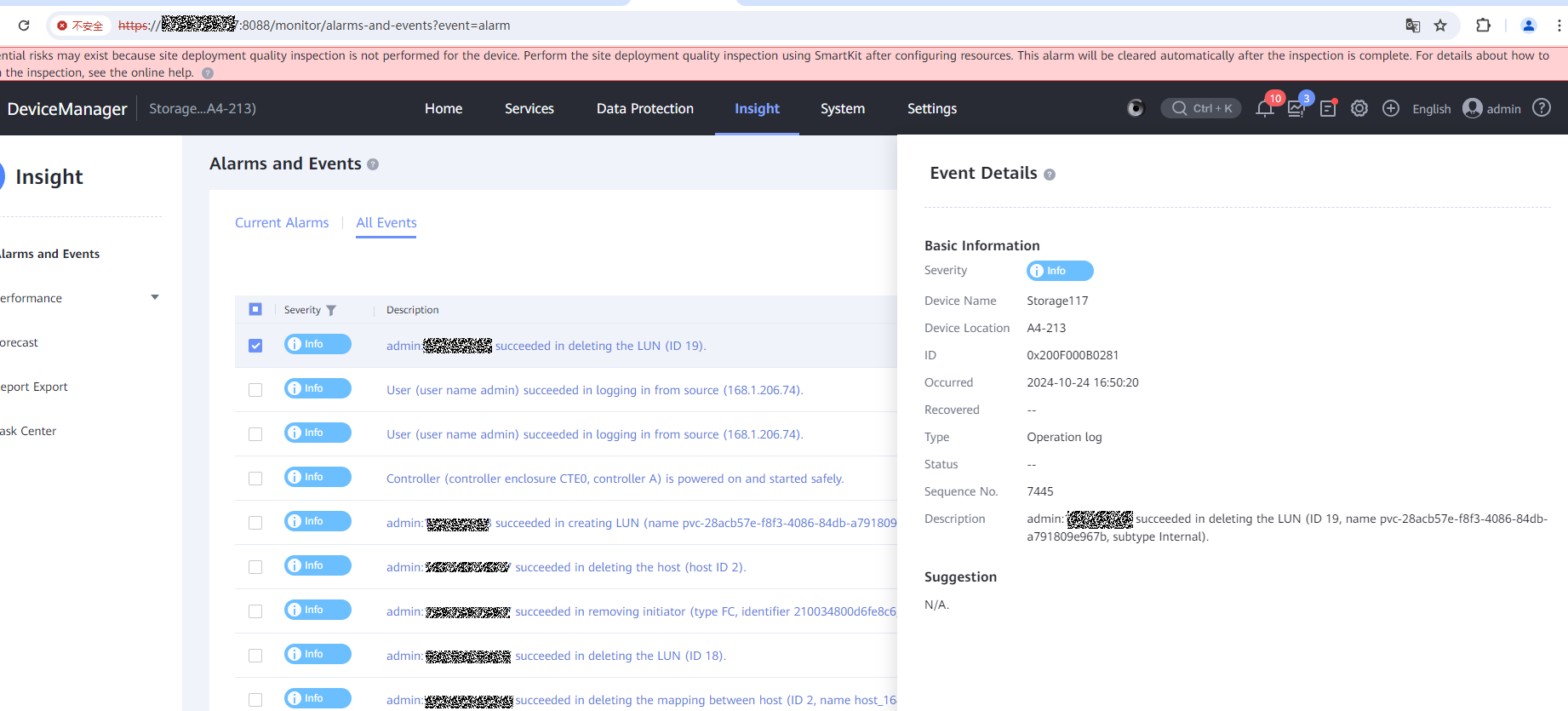
|
Test Conclusion | Passed |
2.2.4 Create, query and delete Pod
Test Purpose | To verify that the Pod can be created, queried and deleted successfully. |
Test Networking | Huawei OceanStor Dorado Storage Function Compatibility Test Networking 1 |
Prerequisites | 1. The storage system is running normally. 2. Red Hat OpenShift is running normally. 3. The network between the storage and OpenShift is connected correctly. 4. Huawei CSI plug-in is configured and started normally. |
Test Procedure |
6. Check the path information and status on the mount node. |
Expected Result |
|
Test Results | 1. In step 2, Pod is created successfully. PVC is created successfully.  Pod is created successfully.  2. In step 3, Pod is queried successfully.  3. In step 4, the path number and status are correct.  4. In step 5, Pod is deleted successfully.  5. In step 6, All the paths are removed, no path information remain.  |
Test Conclusion | Passed |
2.2.5 Configure storage Qos policy with CSI plug-in
Test Purpose | To verify the Qos policy can be configured on the storage with CSI plug-in |
Test Networking | Huawei OceanStor Dorado Storage Function Compatibility Test Networking 1 |
Prerequisites | 1. The storage system is running normally. 2. Red Hat OpenShift is running normally. 3. The network between the storage and OpenShift is connected correctly. 4. Huawei CSI plug-in is configured and started normally. |
Test Procedure | 1. Create and configure the StorageClass config file, and configure the Qos parameter. 2. Create SC. 3. Create PVC. 4. Create Pod. |
Expected Result | 1. In step 2, SC is created successfully. 2. In step 3, PVC is created successfully, the corresponding lun of the PVC is created on the storage with Qos policy configured in step 1. 3. In step 4, Pod is created successfully. |
Test Results | 1. In step 2, SC is created successfully.  2. In step 3, PVC is created successfully, the corresponding lun of the PVC is created on the storage with Qos policy configured in step 1. 
3. In step 4, Pod is created successfully. 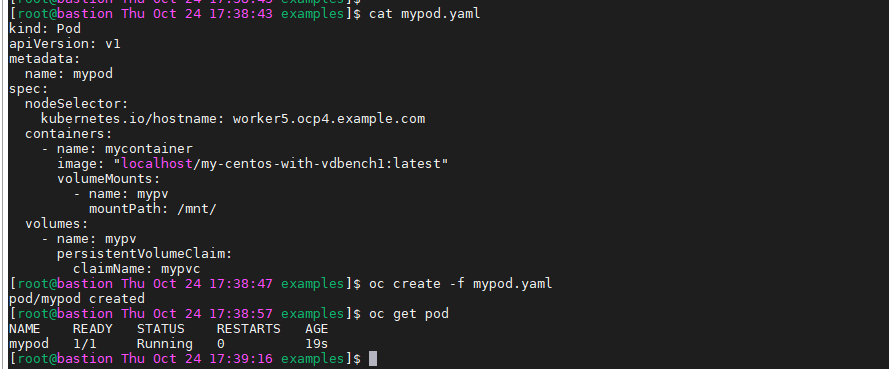 |
Test Conclusion | Passed |
2.2.6 Configure PVC snapshot with CSI plug-in
Test Purpose | To verify the PVC snapshot can be configured successfully with CSI plug-in. |
Test Networking | Huawei OceanStor Dorado Storage Function Compatibility Test Networking 1 |
Prerequisites | 1. The storage system is running normally. 2. Red Hat OpenShift is running normally. 3. The network between the storage and OpenShift is connected correctly. 4. Huawei CSI plug-in is configured and started normally. |
Test Procedure | 1. Create snapshot for the original PVC. |
Expected Result | 1. In step 2, the snapshot is created successfully on the server. |
Test Results | 1. In step 2, the snapshot is created successfully on the server. The SC is created successfully.  The PVC is created successfully.  The Pod is created successfully.  The test file is created successfully.  The snapclass is created successfully.  The snapshot is created successfully.  2. In step 3, the snapshot is created and actived successfully on the storage 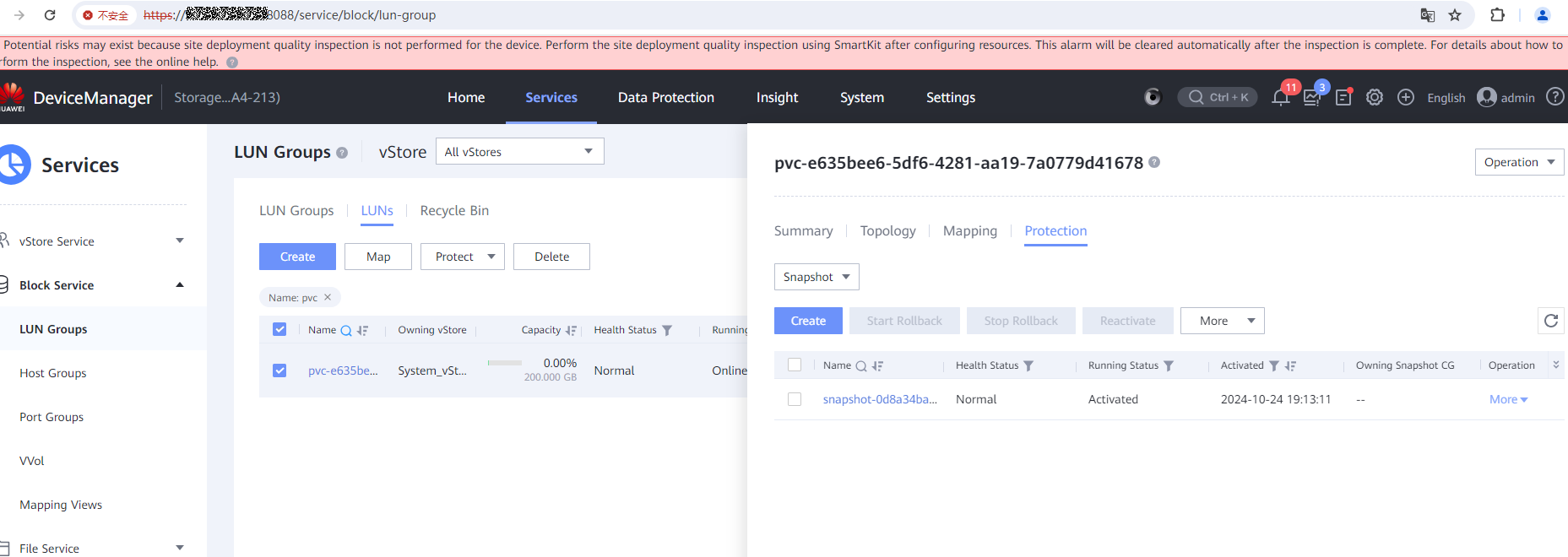 |
Test Conclusion | Passed |
2.2.7 Delete snapshot
Test Purpose | To verify the snapshot can be deleted successfully with CSI plug-in. |
Test Networking | Huawei OceanStor Dorado Storage Function Compatibility Test Networking 1 |
Prerequisites | 1. The storage system is running normally. 2. Red Hat OpenShift is running normally. 3. The network between the storage and OpenShift is connected correctly. 4. Huawei CSI plug-in is configured and started normally. 5. The snapshot of PVC is created successfully. |
Test Procedure | 1. Delete the snapshot. 2. Check whether the snapshot is deleted successfully on the server. 3. Check whether the snapshot is deleted successfully on the storage. |
Expected Result | 1. In step 2, the snapshot is deleted successfully on the server. 2. In step 3, the snapshot is deleted successfully on the storage. |
Test Results | 1. In step 2, the snapshot is deleted successfully on the server. 2. In step 3, the snapshot is deleted successfully on the storage. 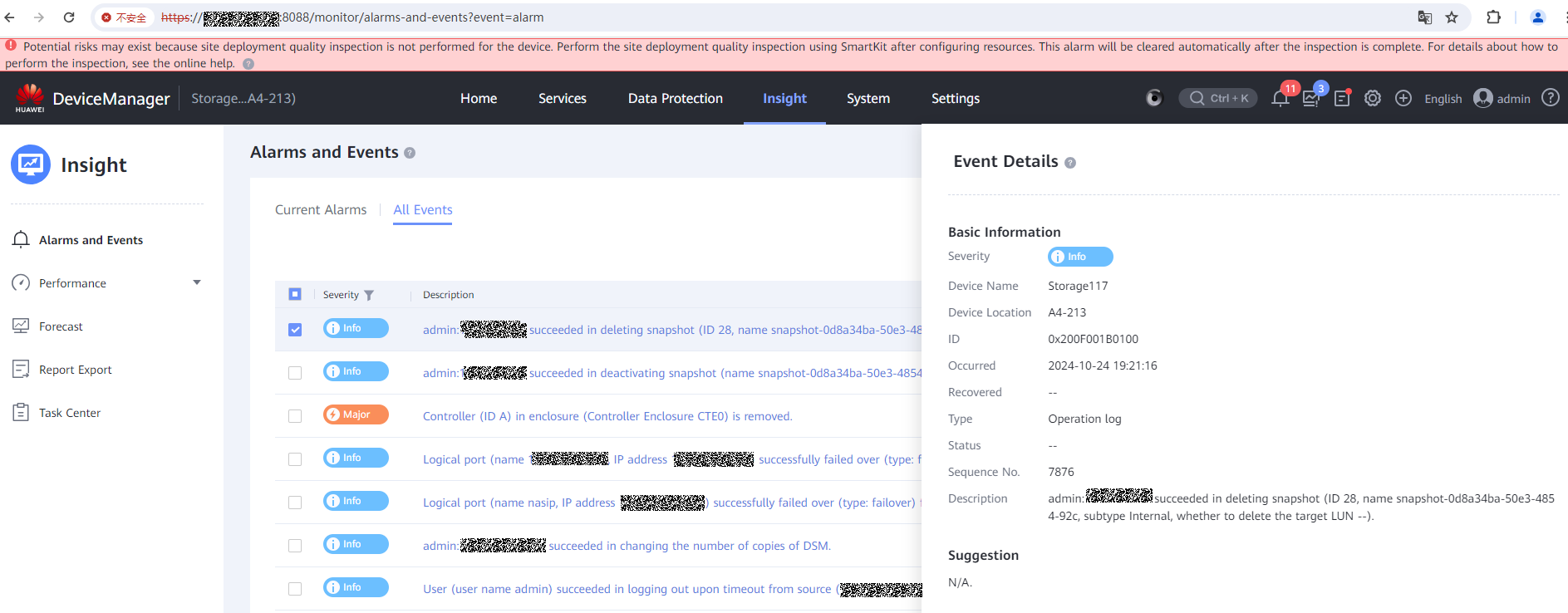 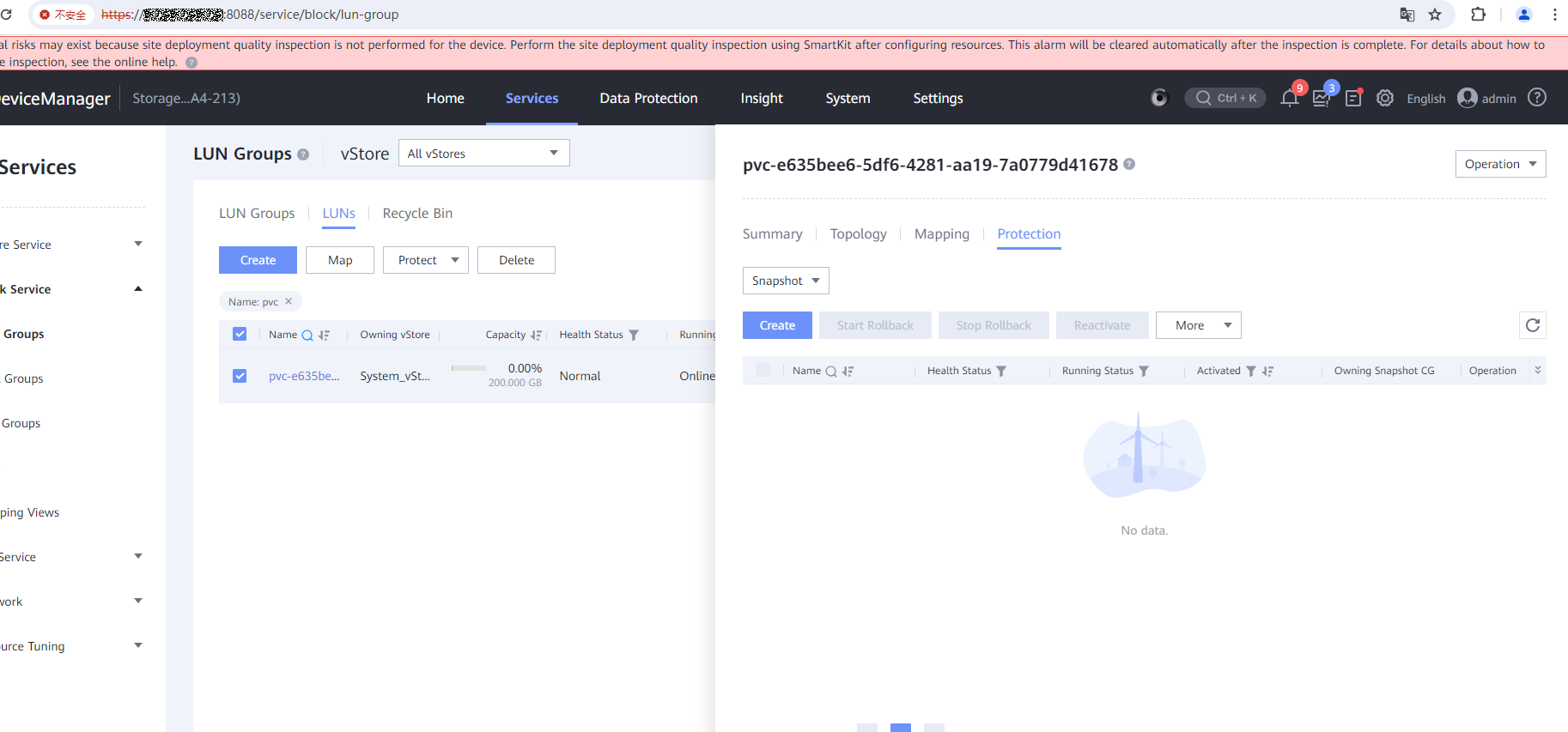 |
Test Conclusion | Passed |
2.2.8 Configure PVC capacity expansion with CSI plug-in
Test Purpose | To verify the PVC can be expanded successfully with CSI plug-in. |
Test Networking | Huawei OceanStor Dorado Storage Function Compatibility Test Networking 1 |
Prerequisites | 1. The storage system is running normally. 2. Red Hat OpenShift is running normally. 3. The network between the storage and OpenShift is connected correctly. 4. Huawei CSI plug-in is configured and started normally. |
Test Procedure | 1. Configure the PVC name and capacity parameter. 2. Expand the PVC. 3. Check the capacity of the PVC 4. Check the filesystem capacity on the storage. |
Expected Result | 1. In step 3, the PVC is expanded successfully on the server. 2. In step 4, the corresponding lun of the PVC is expanded successfully on the storage. |
Test Results | 1. In step 3, the PVC is expanded successfully on the server. Check the capacity of the PVC after expansion  Check the capacity of the PVC after expansion  2. In step 4, the corresponding lun of the PVC is expanded successfully on the storage.  |
Test Conclusion | Passed |
2.2.9 Configure PVC clone with CSI plug-in
Test Purpose | To verify the PVC can be cloned successfully with CSI plug-in. |
Test Networking | Huawei OceanStor Dorado Storage Function Compatibility Test Networking 1 |
Prerequisites | 1. The storage system is running normally. 2. Red Hat OpenShift is running normally. 3. The network between the storage and OpenShift is connected correctly. 4. Huawei CSI plug-in is configured and started normally. |
Test Procedure | 1. Configure the yaml file of SC. |
Expected Result | 1. In step 3, SC is created successfully. 2. In step 4, PVC is cloned successfully, the corresponding lun of the cloned PVC is created successfully on the storage. |
Test Results | 1. In step 3, SC is created successfully.  2. In step 4, PVC is cloned successfully, the corresponding lun of the cloned PVC is created successfully on the storage. The original PVC is created successfully.  The Pod of the original PVC is created successfully. 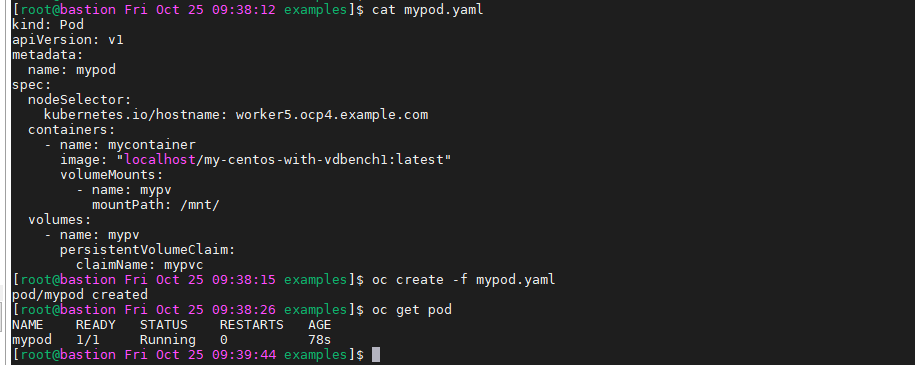 The test file is created successfully in the Pod.  The Cloned PVC is created successfully.  Verify the corresponding lun of the cloned PVC is created successfully on the storage. 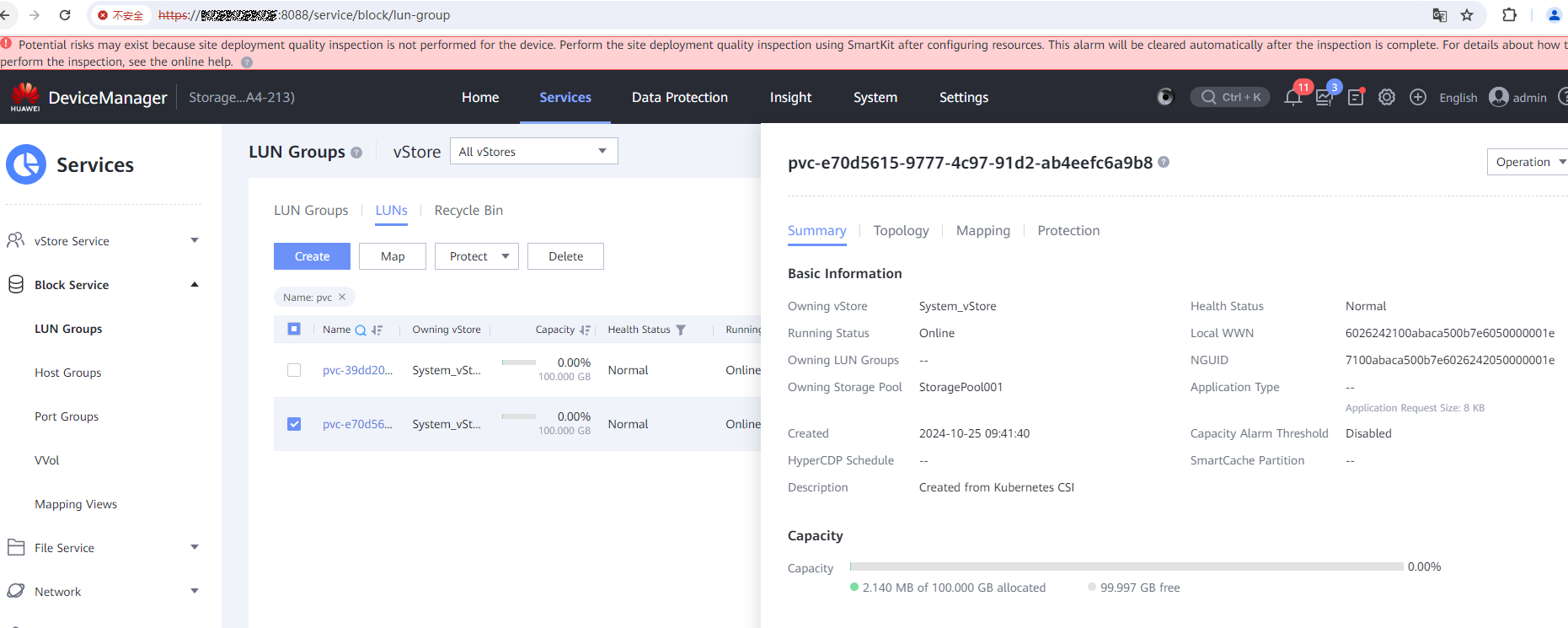 The Pod of the cloned PVC is created successfully. 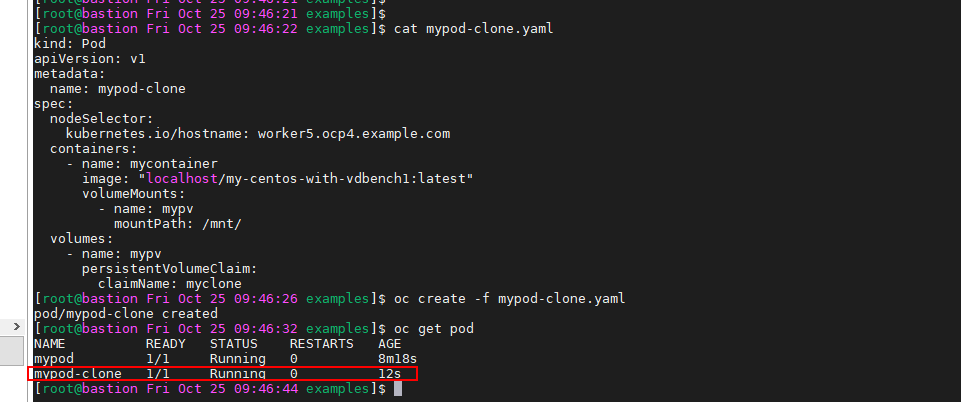 The contents in the test file are compared consistently.  |
Test Conclusion | Passed |
2.2.10 Create new lun from snapshot
Test Purpose | To verify the new lun can be created from snapshot successfully. |
Test Networking | Huawei OceanStor Dorado Storage Function Compatibility Test Networking 1 |
Prerequisites | 1. The storage system is running normally. 2. Red Hat OpenShift is running normally. 3. The network between the storage and OpenShift is connected correctly. 4. Huawei CSI plug-in is configured and started normally. |
Test Procedure | 1. Configure creating lun from snapshot, the target capacity is greater than or equal to the capacity of the snapshot. |
Expected Result | 1. In step 2, new PVC is created successfully. 2. In step 3, the new lun is created successfully on the storage. 3. In step 4, the data is consistent with the original PVC. |
Test Results | 1. In step 2, new PVC is created successfully. 2. The SC is created successfully.  The original PVC is created successfully.  The test file is created successfully in the Pod.  The snapshot is created successfully.  The snapshot is created successfully based on the PVC.  3. In step 3, the new lun is created successfully on the storage.  4. In step 4, the data is consistent with the original PVC. The Pod of new PVC is created successfully.  The contents in the test file are compared consistently.  |
Test Conclusion | Passed |
Acronyms and Abbreviations
Acronyms and Abbreviations | Complete Name |
PV | Persistent Volume |
PVC | Persistent Volume Claim |
SC | Storage Classes |
lun | logical unit number |



